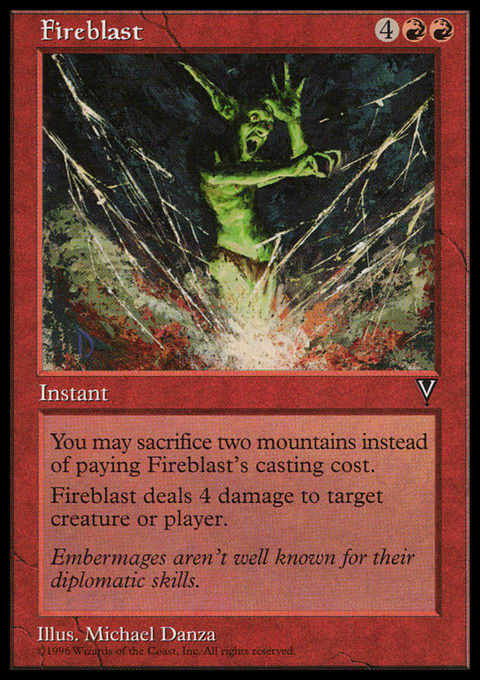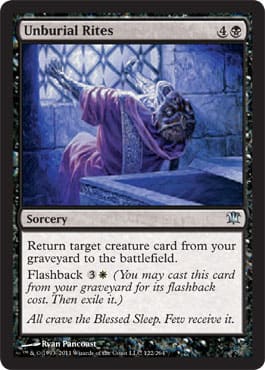The push and pull on playing with multiple colors has been an unending battle for Wizards R&D. They want to encourage variety in order to have a healthy metagame. As a result, they want to include mechanisms and incentives to allow/encourage playing multiple colors; yet at the same time, they want incentives to play monocolored and penalties for playing multicolored. There are four main ways they achieve this:
- Color Specific Costing – The more specific the color requirements to cast a card, the more powerful it is able to be relative to other cards with the same converted mana cost. The less colorless mana in the cost, the higher the power level is, regardless of whether it’s a gold card. This actually helps achieve both goals. This way, they have very powerful cards that you can only take advantage of by playing multiple colors and very powerful cards that are hard to play unless you’re playing monocolored.
- Pool Size – The more colors you play, the more options you have when building your deck, thus directly rewarding playing with multiple colors.
- High-Powered Synergy –Generally, monocolored cards with great color requirements in the casting cost represent the most powerful cards for that color’s part of the color pie. Some examples:
- Ball Lightning and Fireblast are some of the most powerful examples of what it means to be a red mage, but they greatly reward being played in mono-red.
- Drain Life, Necropotence, and Mutilate perfectly represent the black color pie, and if you’re playing monocolored, they’re incredibly powerful.
So if you’re trying to build a deck focused around a quality that a color is known for, you’ll have the highest power level and synergy from playing monocolored.
- Color/Multicolored Hate – From the very beginning, there has been a Magic tradition of making cards that punish specific colors: Tsunami, Blue Elemental Blast, Gloom, and so on. In time, as multicolored decks began to dominate, they made cards that punished you for playing multiple colors: Wasteland, Price of Progress, and Tectonic Edge. Thus, if you pushed too far in either direction in order to gain the rewards for doing so, there were risks you were running.
The current Standard pool seems to be losing this delicate balancing act. The tools and incentives for playing multicolored are there, but the incentives for playing monocolored and penalties for playing multicolored are in short supply. The top decks in Standard at the moment reflect this, and change doesn’t appear imminent, especially based on the cards being previewed for Dragon’s Maze.
Just look at the decks that have dominated Standard events recently. At the time of this writing, there have been nine major Standard events run by StarCityGames in March and April up to and including the Invitational in Atlanta. They were won by R/W/U Flash, Naya Humans, Reanimator, Reanimator, Naya Humans, Naya Blitz, Reanimator, Reanimator, and R/W/U Flash. They had an average of 2.33 basic lands per deck. The greatest number of basic lands was four, and Aaron LeBlanc’s Naya Blitz deck had zero basic lands! (As an aside, to all those people who commented Unburial Rites wasn’t one of the Standard Power Nine: Suck it! . . . ahem, I mean, it looks like Reanimator has been doing pretty well . . . )
Every single one of these decks was three colors. Most considered their mana bases so stable that six of them even played with various lands that only produced colorless mana, such as Kessig Wolf Run and Gavony Township. Not all of these decks were playing with prodigious amounts of mana to help cover their colors either; Aaron’s Naya deck only had twenty lands.
Looking at the Top 8s of all nine events, there were even four decks that were running four colors. Of the seventy-two decks in these Top 8s, there were only three decks running just two colors and only a single monocolored deck! This data is just the tip of the iceberg, but it makes clear the point that you can see evidence of for yourself at Friday Night Magics and at any other sanctioned Standard event these days: The color balance in deck construction is incredibly skewed in favor of multicolored decks.
The previews of Dragon’s Maze so far don’t indicate that we can expect this to change anytime soon. Not only is Dragon’s Maze chock-full of powerful gold cards and multi-lands, but it even introduces some new reasons to play multiple colors. There are creatures called Gatekeepers in each color. They’re all 2/4s for 4 mana, but they each give you a different cool reward if you have at least two Gates in play. This basically means that if you play them in a monocolored deck, they’re lame, but if they’re in a multicolored deck, they can be pretty powerful. There are even gold split cards that encourage you to play three colors because the two halves only have one color in common.
Not only does it not appear that Wizards will be doing anything to punish playing multicolored in Dragon’s Maze, but it also doesn’t even appear that they will be rewarding players if they choose to go monocolored. This leads us to the big questions. What does this all mean? How will the game be affected going forward?
The key to answering these questions is to determine what WotC’s motivations for doing it are. Is this just a block gimmick or is it a new direction that R&D has decided to move in as a matter of policy? It’s quite common for Wizards to reshape the fundamental landscape of the game temporarily as a way to help give a particular expansion block an interesting identity. While that is definitely happening here, it also might be more than that.
One of the primary ways WotC keeps the game interesting is by moving around the balance of the game. Just compare Scars of Mirrodin block to the current format. Back then, artifacts were a dominant force in the Standard metagame; now they see little to no play, and having artifact hate in your sideboard seems to be a total waste of time. The viability and importance of artifacts is one of many dials that R&D likes to play with when they’re exploring themes for expansion sets. Gold cards and such are another.
Yet, when was the last time we saw good hate for multicolored decks? Tectonic Edge was pretty good for that, but the Edge came out three years ago. It seems extremely likely that R&D has decided to focus more on the positive than the negative. More carrot and less stick, you might say. Rather than punish various strategies with hate, they’re encouraging diversity and a healthy metagame by making more options viable and by giving incentives for more strategies. They may also be trying to pander to their customer base, which clearly enjoys sets with a lot of gold cards and support for playing with them. Of course, the proof will be in future sets more than in Dragon’s Maze. For now, though, enjoy going for the gold and playing with several colors.


























